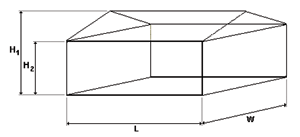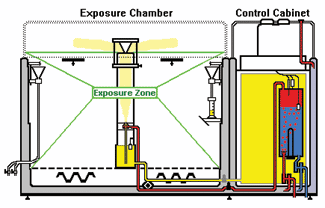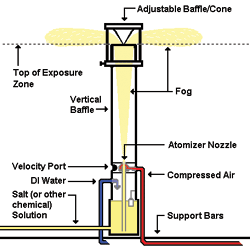Quality Finishing: How to Select a Cyclic Corrosion Test Cabinet
To determine the most cost-effective materials to use in a corrosive environment, manufacturers routinely test raw materials, partial assemblies, randomly selected production pieces, finished items, returned goods, and competitors’ products.
#measurement-testing #basics
To determine the most cost-effective materials to use in a corrosive environment, manufacturers routinely test raw materials, partial assemblies, randomly selected production pieces, finished items, returned goods, and competitors’ products. Buyers, government agencies, and consumer groups also test finished products for contract compliance, military/industry specifications, and consumer safety.
Corrosion testing provides data to assess the probable degree of material degradation in the real world, which has both natural and man-made stresses. There is no universal corrosion test, because the many independently variable environmental conditions create varying individual and synergistic reactions in the material. To predict “service life” for corrosive stresses, and find the most economical means to achieve minimally acceptable material performance, every condition that the material will encounter should be duplicated by the selected corrosion test method.
Featured Content
There are two types of lab corrosion tests that have been developed during the past 70 years: traditional salt spray (fog) and cyclic (See Figure 1). Cyclic testing is further divided into two types of tests: basic and advanced.
Cyclic testing is popular because of the improved reliability of results, which can be correlated with outdoor exposures. Coatings and other protective systems can be developed and tested under accelerated conditions, giving design engineers and others who specify materials a competitive advantage for bringing superior-performing products to market.
Historical Salt Fog Testing
Traditionally, corrosion testing was called salt fog, salt spray or salt bath testing. It typically involved placing samples into a steady environment of saturated relative humidity (RH), with a condensing fog made from 5-20% NaCl solution and a temperature of 35-40C for a specified length of time, such as 1,000 hours. A variation was 100% RH from water without salt or other chemical, often referred to as a humidity test.
| TABLE 1: Operating Cycles of Cyclic Corrosion Test Chambers | |
| Cyclic Conditions in Basic Cyclic Cabinets* | Cyclic Conditions in Advanced Cyclic Cabinets* |
| 1. Salt or Chemical (electrolyte) Fog, saturated RH | All in preceding column, plus: |
| 2. Water Fog, saturated RH | 9. Controllable Humidity, ambient to saturated RH |
| 3. Dry-off | 10. Immersion |
| 4. Dwell, a period of rest where no action is taken |
11. Second Electrolyte, for fog or direct spray |
| 5. Non-Condensing Humidity (i.e. moist heat) | 12. Low Temperature, to –30C |
| 6. Direct Spray (impingement), salt or other chemical |
13. Ambient Temperature and RH |
| 7. High Temperature, up to 71C | |
| 8. Gas Injection, including NOx, SO2, CO2, etc | |
| *Some cycles may require optional equipment | |
The intent in those early days was to determine the probability of corrosion by ranking the rate-of-spread of corrosion, or simply categorizing as pass or fail. However, since the real world does not have unchanging conditions of 5% (let alone 20%!) salt in 100% humidity at 35C, no correlation to service life or end-use determinations could be made, although many labs did so.
Cyclic Testing
Cyclic testing is an attempt to replicate varying end-use environments. In the early 1970s a prototype test was developed that inserted a dry-off period between episodes of high humidity. The reason for this was the proved observation that most corrosion takes place during transition from wet to dry and back, not when an item is continuously wet.
During the development of cyclic testing, a technician placed a sample in a testing cabinet that had a specific condition such as corrosive fog. When the prescribed time elapsed, the sample was moved to the next condition that simulated a different environmental condition. That second condition could have been created in an oven (dry heat), a lab bench (ambient temperature), a sink (spray, immersion), and so on.
This type of operator-dependent sample movement is no longer necessary. Advanced cyclic cabinets bring multiple environments to the sample. This provides repeatable test conditions, reduced operator error, timesavings, and greatly improved reproducibility. Depending on installed options, a cabinet can create up to 14 environmental cycles in any order, replicating the variety of end-use conditions.
Operating Cycles
An advanced cabinet with installed optional equipment can create all thirteen cycles (See Table I), reducing the need for multiple cabinets to perform different tasks. This significantly reduces depletion of precious resources. Advanced cabinets can perform virtually all traditional tests and cyclic tests and provide for future testing needs.
Get What You Pay For
Exposure Zone and Free Settling of Fog. A 30 cubic foot / 850 liter chamber from one manufacturer may actually be smaller than the 20 cubic foot / 565 liter chamber from another manufacturer. This is because some manufacturers exaggerate the volume of their exposure zone by including space with the angled cover or below the exposure zone. Do the math to determine the actual volume available for testing. Multiply L × W × H of the actual exposure zone, using the definitions below.
The boundaries of an Exposure Zone (Fig. 2) are:
- Top. The plane-of-entry of fog – space above this plane has laterally moving fog.
- Bottom. The lowest point at which a sample receives direct condensation without being shielded or otherwise affected by diffuser plates, heating elements, or a false floor.
- Sides. The interior walls where condensation occurs.
Volume within an angled cover or below a diffuser plate cannot be used for sample exposure. Note these typical test requirements, some of which are the basis for many other tests:
ASTM B117 Paragraph 7.1.3 (page 2):Each specimen shall be so placed as to permit free settling of fog on all specimens.
ASTM G85 Paragraph 7.1.3 (page 2):Place each specimen so as to permit free settling of fog on all specimens.
JIS Z 2371 Paragraph 5(3) (page 3):Each specimen shall be so positioned and spaced as to not interfere with the free falling of the spray.
ISO 9227 Paragraph 7.1 (page 5):The test specimens shall be placed in the cabinet so that they are not in the direct line of travel of spray from the atomizer.
“Free settling of fog” refers to condensation as it responds to gravity and is no longer pushed by the force that produced and/or distributed it. This automatically excludes space within a cabinet where fog is moving laterally away from the nozzle. Another way to determine if a manufacturer is exaggerating the size of its exposure zone is look for a diagram that shows L × W × H (See Fig 3). If there are two heights listed, such a H1 and H2, it is probable that H1 is being used as a multiplier.
Manner in Which Fog Is Distributed. This is a very important consideration. The following test methods are the basis for dozens of other tests:
ASTM B117 Paragraph 10.3 (page 3):The nozzle or nozzles shall be so directed or baffled that none of the spray can impinge directly on the specimens.
ASTM G85 Paragraph 4.3.3 (page 2):Direct or baffle the nozzle or nozzles so that none of the spray can impinge directly on the test specimens.
JIS Z 2371 Paragraph 5(3) (page 3):The sprayed particles shall, as a rule, naturally settle, and be baffled from impinging directly on a specimen with the atomizing nozzle turned to a direction where the specimen is clear of the direct spray.
ISO 9227 Paragraph 4.3 (page 2): Baffles may be used to prevent direct impact of spray on the test specimens and the use of adjustable baffles is helpful in obtaining uniform distribution of the spray within the cabinet.
An advanced cabinet will double baffle the fog. The first baffle is a vertically oriented pipe, the second is an inverted cone, or other type of distribution device, at the top of the tower (Fig. 4). The vertical pipe guides the fog upward until it is above the exposure zone. The inverted cone directs the fog evenly above the exposure zone. Older style cabinets that merely deflect fog against the inside of the cover are less efficient at evenly distributing fog.
Testing Plane and Sample Capacity. Typically, samples to be exposed are coated steel panels that come in two sizes; 3 × 6 inch (7.6 cm × 15.2 cm), or 4 × 12 inch (10 cm × 30.5 cm), usually 0.0625 - 0.125 inch (0.16 cm to 0.32 cm) thick. Most test methods require that these panels are exposed at 15 degrees from vertical, at a spacing of 1.5 inch (3.8 cm) so that condensation will settle evenly on all parts of each panel.
The testing plane is the L × W, measured inside the exposure zone. The larger the testing plane, the more samples that can be exposed, which is an advantage when there are many panels to test.
Floor Space Requirements. Cabinets with advanced design need access only from the front for sample positioning, calibration, and normal maintenance. Such design requires less floor space than older models that also require access for servicing from one or both sides and, in some extreme cases, from the back. Those older designs often require 25-50% more floor space.
Laboratory Aesthetics. Many companies are now looking at their lab as a “show place.” Bringing a customer to a laboratory to show advanced capabilities is an increasing trend. With this in mind, it is important to choose a cabinet that is both functionally advanced and pleasing to the eye. Modern cabinet designs can add to the overall perception that a lab is up-to-date and capable.
Unattended Operation. Since the very idea of a cyclic cabinet is to reduce hands-on time, it makes sense to select a cabinet that needs as little attention as possible. After sample movement, the most likely item that consumes an operator’s time is the need to mix batches of salt solution or other electrolyte. The volume of built-in solution reservoirs range from less than 30 gallons up to 60 gallons and even 100 gallons.
Installation Requirements. Before the installation of a cyclic cabinet, there are utility connection, environmental, and floor space considerations. Ask the manufacturer of the equipment for a list of utility connections and operating conditions. Very careful attention must be given to removing corrosive gasses from a cyclic cabinet. Proper venting must protect surrounding equipment, personnel, and other samples.
- Floor space. Request a floor space diagram from the manufacturer. Is adequate space (32 inch or 81cm) available for all sides requiring access to samples, and for calibration and maintenance?
- Utilities. Access to electrical service, deionized water (per ASTM D1193 or similar authority), and a floor drain are necessary.
- Venting. Lab corrosion cabinets are well known for causing corrosion to nearby equipment, which is usually due to poor venting. When an outside wall or roof vent is not available, the manufacturer should offer alternate means to dispose of corrosive air.
- Operating Conditions. Ideally, the installation of a corrosion cabinet is in a climate-controlled area, where the temperature ranges from 65-80F (18-27C). Higher or lower temperatures may negatively affect proper operation and conformance to certain test parameters. Humidity should be 30-50%; higher or lower humidity will affect conformance to parameters of a dry-off cycle. Dust should be minimized, since it can contaminate both samples and salt solution. Options and Accessories. Each manufacturer offers options (usually factory installed) or accessories to expand testing capabilities or to increase operator efficiency. Typical options for an advanced lab cabinet are:
- Adjustable Humidity. Automatically controls relative humidity at the set point; used to prolong the transition time between wet and dry.
- Direct Spray. Provides a means to directly spray samples with a steady rain” of the specified solution.
- Immersion System. Automatically transfers solution into the exposure zone where samples are flooded/immersed.
- Automatic Retracting RH Probe. Upon signal from the cabinet controls, inserts and retracts the sensitive RH probe (thin-film dielectric), protecting it from corrosive atmospheres.
- Air Operated Cover Lifters. Automatically lifts the cover when a test method calls for ambient conditions. This is an advantage if this condition is required when an operator is not present, such as evenings, weekends and holidays.
- PC-Based Software. The most powerful and versatile of all controlling and recording options, Pentium™ computer controls and records all functions, including set points, readings, multi-pen trending, input/output status for components, and alarms. The operator can monitor and change conditions inside the cabinet; and can allow remote troubleshooting thereby reducing service costs.
- Mixing System for Salt Solution Reservoir. When activated by the operator, injects air into the solution reservoir that thoroughly mixes the soluble chemicals with the DI water.
- External Condensate Collection Package. Includes all necessary equipment to check the condensation rate without opening the cover.
- Gas Injection. Allows certain gasses, used to simulate industrial pollution, to be injected into the condensing fog.
- Extra Solution Tank. A second reservoir to provide for longer unattended testing, or to supply a second electrolyte to become fog or used as direct spray.
- Access to components for maintenance, service. The latest cabinets have removable or “palletized” component assemblies. Before servicing or replacing any component, always shut off the electrical power at the wall switch and turn off and depressurize both the incoming DI water and compressed air.
Regular maintenance ensures uninterrupted operation, conformance to test specifications, and preservation of the manufacturer’s warranty. The operator should make a spreadsheet to track maintenance requirements as specified in the manufacturer’s operating manual.
Comparison of various models of cyclic corrosion cabinets is not difficult when testing needs are known and specifications are compared. The number, shape and size of samples to be tested indicate the necessary cabinet size in terms of exposure volume or testing plane. When cabinet size is determined, narrow your search to those with the proper manner of making and distributing fog. Then, find the cabinets with the necessary operating cycles for current and future needs. Finally, determine the best combination of floor space use, length of unattended operation, available options and accessories, appearance, technical service after installation, manufacturer reputation and overall value/cost. The best cabinet for the job is not necessarily the largest or most expensive. Don’t buy more – or less – than what is needed.
Reproduced with permission from NACE International, Houston, TX. Published in the February 2003 issue of Materials Performance.
Atlas Material Testing Technology LLC
RELATED CONTENT
-
Powder Coating Overcomes Post Forming
Six Sigma methodology, open communication, and collaboration produce results for leading boat manufacturer.
-
Electronic Timer Versus Stopwatch
Coating thickness measurement for process control and improvement
-
Test Methods For Evaluating Anodized Aluminum
Benefits of anodizing include durability, color stability, ease of maintenance, aesthetics, cost of initial finish and the fact that it is a safe and healthy process. Maximizing these benefits to produce a high–performance aluminum finish can be accomplished by incorporating test procedures in the manufacturing process.






















